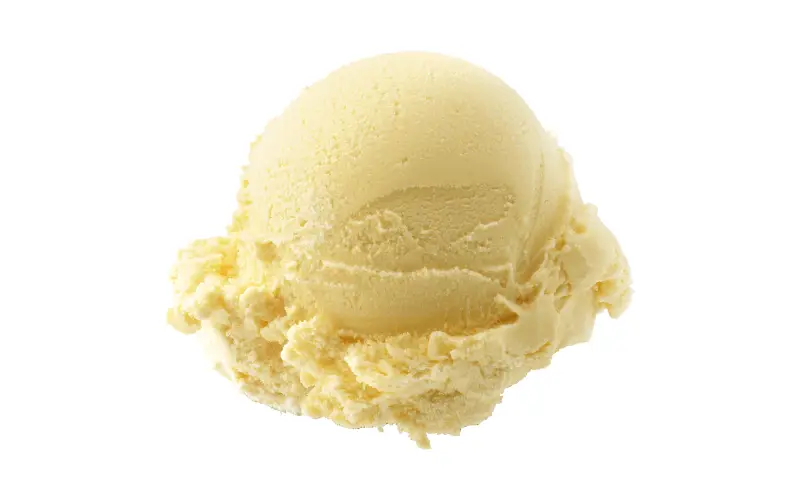When we think of vanilla ice cream, a creamy white color often comes to mind. However, it’s not uncommon to find vanilla ice cream with a subtle hint of yellow.
This golden hue may raise a few eyebrows but in most cases it’s normal and the ice cream is safe to eat. Here’s the scoop on why your vanilla ice cream is yellow!
Yellow Vanilla Ice Cream Explained
While you certainly should be cautious about eating yellow snow for obvious reasons, yellow vanilla ice cream is generally completely normal.
But, why?
Well, the most common reason that a vanilla ice cream is yellow is because it contains egg yolks. The number of yolks used in the ice cream impacts the color. You can find vanilla ice cream products from a pale yellow color to a more golden hue depending on how many yolks are used.
The types of vanilla ice cream that typically contain eggs are French, old fashioned, and homemade.
Ice cream manufacturers are required to list egg yolks in the ingredient list printed on the carton if an ice cream contains them. You can reference the ingredients if your ice cream is yellow and you are wondering if egg yolks are the culprit.
Why Are Eggs In Vanilla Ice Cream?
Eggs play a crucial role in the creation of traditional custard-based vanilla ice cream. The inclusion of eggs brings several benefits to the texture, flavor, and overall quality of the ice cream. Here are some key reasons why eggs are commonly used in vanilla ice cream recipes:
- Texture and Creaminess: Eggs contain proteins and fats that contribute to the creamy and smooth texture of ice cream. When eggs are combined with milk and sugar and then cooked to create a custard base, they form a stable emulsion. This emulsion helps prevent the formation of ice crystals during freezing, resulting in a velvety and luxurious mouthfeel.
- Emulsification: The egg yolks in particular contain emulsifiers that help bind the fat molecules in the cream and milk, creating a stable mixture. This emulsification process enhances the overall consistency of the ice cream and prevents the separation of fats and liquids during freezing.
- Flavor Enhancement: Egg yolks contribute to the flavor profile of vanilla ice cream. The fats in the yolks can carry and enhance the flavor of the vanilla extract, resulting in a richer and more well-rounded taste. The natural fats also add a satisfying richness to the ice cream.
- Color Contribution: As we’ve mentioned, egg yolks often make vanilla ice cream yellow in color.
- Stabilization: Eggs help stabilize the ice cream mixture, providing a structure that prevents the formation of ice crystals. This stability is essential for creating a smooth and creamy consistency in the finished product.
Does All Vanilla Ice Cream Have Eggs?
No, not all vanilla ice cream has eggs. Some modern recipes, especially those geared toward a simpler or egg-free approach, may use alternative stabilizers and emulsifiers to achieve a similar texture without the use of eggs. However, traditional custard-based recipes often rely on the unique properties of eggs to create a classic vanilla ice cream experience.
Other Factors Influencing Color
Below are some other factors that can contribute to the yellow color of a vanilla ice cream:
The Vanilla Effect:
Vanilla, the signature ingredient in vanilla ice cream, is derived from the beans of the vanilla orchid. The natural color of vanilla extract is not crystal clear but rather has a warm, amber hue.
The vanilla can can contributed slightly to yellowing the ice cream. However, those familiar with using it in baking know that a little goes an extremely long way. In other words, ice cream typically doesn’t contain enough vanilla to significantly affect flavor.
Air and Light Exposure:
Vanilla ice cream’s color can also be affected by air and light exposure during the freezing process. Oxygen can cause the vanilla to undergo oxidation, leading to a darker color. Moreover, exposure to light can accelerate this process. Ice cream that has been improperly stored or left out for extended periods may display a more intense yellow color due to these factors.
Type of Milk:
The type and quality of milk used can play a role. Milk from grass-fed cows, for example, may contain more beta-carotene, a natural pigment found in plants, which can contribute to a warmer, yellowish color in the final product.
Spoilage:
The formation of ice crystals and other textural issues are generally signs that ice cream has gone bad. Color changes are generally not a often cited issue with ice cream spoilage. However, if you notice your ice cream has changed colors from say an off white to yellow, it is best to discard the ice cream.
Final Thoughts
In the end, the golden color of vanilla ice cream is typically a testament to the natural variations in ingredients and the choices made during the production process. Whether it’s the use of pure vanilla extract, the addition of egg yolks, or the quality of milk, each element contributes to the final appearance of this classic dessert.

